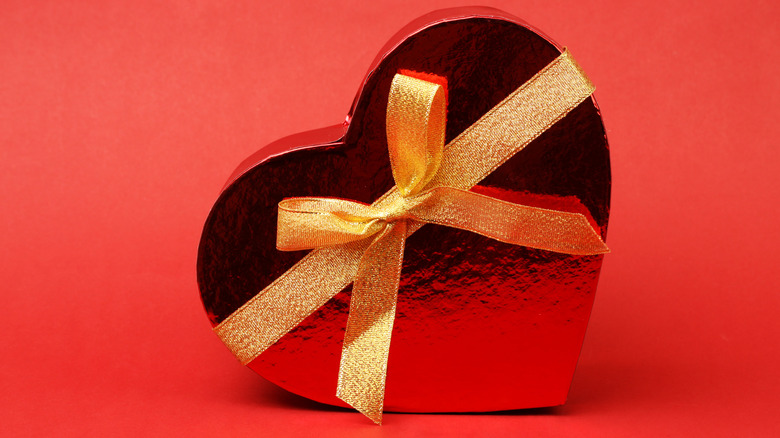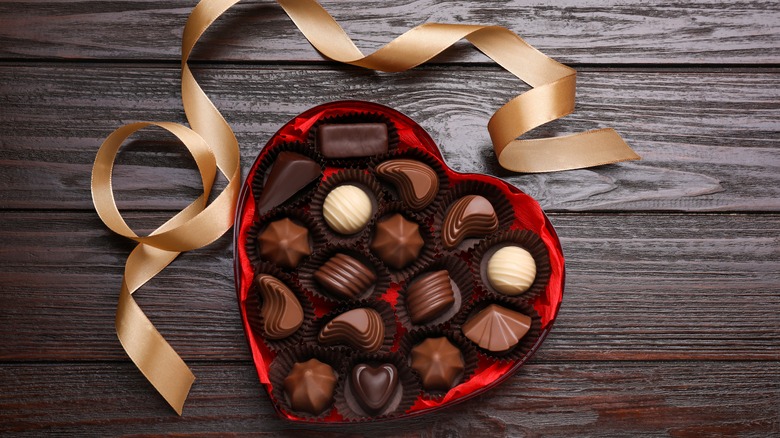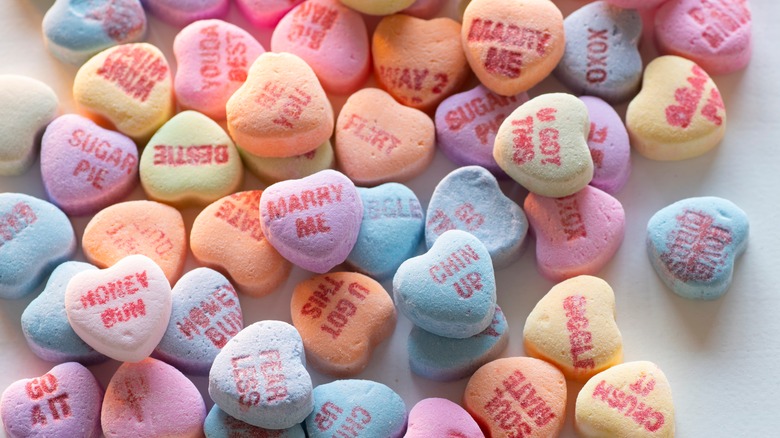The First Known Box Of Valentine's Day Candy Was Too Pretty To Eat
Buying sweets for one's sweetie is a Valentine's Day tradition that dates back well over 100 years. But the romantically-themed candies and chocolates, and how they're packaged, have certainly changed a bit over the years. The first boxes of Valentine's Day candy in the 1890s, for example, were often too pretty for their contents to be eaten.
That's because confectioners of the era built their boxes of candy to be works of art. The most notable of these featured pink candies under glass in a heart-shaped box, surrounded by candied roses, and encased in pink satin, with "For my valentine" in embossed gold leaf lettering, observed an 1894 article in The New York Times. The boxes were built to last for decades, but for those who couldn't resist the lure of delicious candy, it was noted that the packaging could still be used to hold jewelry once emptied.
This idea of offering sweets in a romantic commemorative box that could later be used for other purposes was not invented by New York confectioners of the Gilded Age, however, but rather by a famed British chocolatier.
How chocolate became a staple of Valentine's Day gift-giving
Valentine's Day has been linked with romance since at least the 14th century. But somehow it took another 500 years or so for chocolate to enter the picture. Its appearance was suitably sentimental and spectacular, however, thanks to Richard Cadbury, whose family had been making chocolate in England since 1824.
Guinness World Records credits Cadbury as the maker of the first ever heart-shaped box of chocolates, and dates the invention to 1868. Cadbury's creations perhaps weren't as ornate as the confectionary candy boxes later built in New York, but they did exhibit a high degree of both romantic feeling and artistic flair. The chocolate boxes were lovingly designed, for example, and illustrated with Cadbury's own paintings. Rather than Valentine's Day sweethearts of the time using them as jewelry boxes after the chocolates were gone, Cadbury advocated reusing the heart-shaped keepsakes for love letters or locks of a loved one's hair.
Artistry aside, Cadbury wanted purchasers to taste chocolate as represented in the boxes' samplers, as he had pioneered a delicious new method for making what was known as 'eating chocolate' (versus drinking chocolate) using pure cocoa butter.
The evolution of heart-shaped Valentine's Day candy and packaging
Cadbury remains an iconic name in chocolate making today, despite Richard Cadbury's failure to patent his ingenious heart-shaped Valentine's Day-themed packaging. American-born companies like Ghirardelli, Russell Stover, and Whitman's (the three are now owned by Swiss chocolate giant Lindt & Sprüngli) soon followed suit, and the heart-shaped chocolate box became a Valentine's Day staple.
New York confectioners, as noted, were making both candy and boxes in heart shapes by the 1890s. But Necco, a New England confectioner, seems to have been the first company to take the heart-shaped candy idea and market it on a nationwide scale. Its Sweethearts began appearing in that shape in 1902, with signature romantic messages like "Be Mine" or "Kiss Me" embossed on the front, per Smithsonian.
Of course, it took a while for Necco to give its candies their current shape, as the company had originally manufactured them to look like shells and baseballs. But as we all know now, there's no such thing as too much romance, especially when candy is involved, and eating and drinking on Valentine's Day typically must include said candy.



